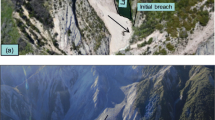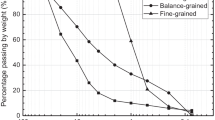Abstract
Recently, the occurrence of landslide dam problems has been aggravated due to the effects caused by climate change and the further expansion of land use in mountainous areas. Knowledge of landslide dam formation and its geometry is very necessary to accurately evaluate dam stability and hence provide good predictions for disaster preparedness. In previous studies, landslide dam formation was considered as a separate issue; its link with slope failure was ignored, and thus their description and interpretation are still inadequate. Previous models also were limited to evaluate landslide dam shape in 2 dimensions (2D). Through a series of experiments, this study aims to analyze the effect of different slope failure mechanism on the formation of landslide dam. This study also integrated 2D seepage flow model, 2D slope stability model, landslide dam-geometry evaluation model in a single unit and proposed a new method to estimate the landslide dam shape in lateral direction (3D). The experimental results indicated that in the sudden failure, the failed mass can quickly block the river width, making a high impact in regard to dam construction. In retrogressive failure, the shape of dam was formed layers by layers which slowly span to the other side of river and to both up and downstream direction. The results also showed the failed volume and river bottom slope are the two most essential factors that dominate the shape of landslide dam. The simulation results including the failure surface, landslide volume and shape of landslide dam in lateral direction were comparable with those observed from the experiments.
Similar content being viewed by others
References
Brand, E. W. (1981). “Some thoughts on rainfall induced slope failures.” Proceedings of 10th International Conference on Soil Mechanics and Foundation Engineering, pp. 373–376.
Costa, J. E. and Shuster, R. L. (1988). “The formation and failure of natural dams.” Geol. Soc. Am. Bull 100, pp. 1054–1068.
Costa, J. E. and Schuster, R. L. (1991). “Documented historical landslide dams from around the world” Open-File Report (United States Geological Survey), pp. 91–239.
Do, X. K., Jung, K. S., Lee, G. H., and Regmi, R. K. (2015). “A study on rainfall induced slope failure: Implications for various steep slope inclinations.” Korean geo-environmental Society, Vol. 17, No. 5, pp. 5–16, DOI: 10.14481/jkges.2016.17.5.5.
Ermini, L. and Casagli, N. (2003). “Prediction of the behavior of landslide dams using a geomorphological dimensionless index.” Earth Surf. Processes Landforms, Vol. 28, No. 1, pp. 31–47, DOI: 10.1002/esp.424.
Freeze, R. A. (1971a). “Three dimensional transient, saturated unsaturated flow in a ground water basin.” Water Resources Research, Vol. 7, No. 2, pp. 347–366. DOI: 10.1029/WR007i002p00347.
Freeze, R. A. (1971b). “Influence of the unsaturated flow domain on seepage through earth dams.” Water Resources Research, Vol. 7, No. 4, pp. 929–941, DOI: 10.1029/WR007i004p00929.
Freeze, R. A. (1978). “Mathematical models of hill slope hydrology.” Hillslope Hydrology (Ed. Kirkby, M.J.), pp. 177–225.
Gregoretti, C., Maltauro, A., and Lanzoni, S. (2010). “Laboratory experiments on the failure of coarse homogeneous sediment natural dams on a sloping bed.” Journal of Hydraulic Engineering, ASCE, Vol. 136, No. 11, pp. 868–879, DOI: 10.1061/(ASCE)HY.1943-7900.0000259.
Hunger, O. (1995). “A model for the runout analysis of rapid flow slides, debris flows and avalanches.” Canadian Geotechnical Journal, Vol. 32, No. 4, pp. 610–623.
Hunger, O. (2006). “Prospects for prediction of landslide dam geometry using empirical and dynamic models.” Italian Journal of Engineering Geology and Environment Special Issue, pp. 151–155, DOI: 10.4408/IJEGE2006-01.S-21.
Kuo, Y., Tsang, Y., Chen, K., and Shieh, C. (2001). “Analysis of landslide dam geometries.” J. Mt. Sci., Vol. 8, No. 4, pp. 544–550, DOI: 10.1007/s11629-011-2128-1.
Mizuyama, T., Satohuka, Y., Ogawa, K., and Mori, T. (2006). “Estimating the outflow discharge rate from landslide dam outbursts.” Disaster Mitigation of Debris Flows, Slope Failures and Landslides, pp. 365–377.
Orense, R., Shimoma, S., Maeda, K., and Towhata, I. (2004). “Instrumented model slope failure due to water seepage.” Journal of Natural Disaster Science, Vol. 26, No. 1, pp. 15–26, DOI: 10.2328/jnds.26.15.
Peng, M. and Zang, L. M. (2012).”Breaching parameters of landslide dams.” Landslides, Vol. 9, No. 1, pp. 13–31, DOI: 10.1007/s10346-011-0271-y.
Rahardjo, H. and Fredlund, D. G. (1995). “Procedures for slope stability analyses involving unsaturated soils.” Developments in deep foundations and ground improvement schemes, Balkema, Rotterdam, The Netherlands, pp. 33–56.
Regmi, R. K. and Jung, K. S. (2015). “Application of dynamic programming to locate the critical failure surface in a rainfall induced slope failure problem.” KSCE, Vol. 20, No. 1, pp. 452–462, DOI: 10.1007/s12205-015-0183-9.
Satofuka, Y., Mori, T., Mizuyama, T., Ogawa, K., and Yoshino, K. (2010). “Prediction of floods caused by landslide dam collapse.” Journal of Disaster Research, Vol. 53, No. 3, pp. 288–295.
Sharma, R. H. and Nakagawa, H. (2005). “Shallow landslide modeling for heavy rainfall events.” Annuals of Disas. Prev. Res. Inst., Kyoto Univ., No. 48B, 2005.
Shin, H., Kim, Y. T., and Park, D. K. (2012). “Development of rainfall hazard envelop for unsaturated infinite slope.” KSCE, pp. 351–356, DOI: 10.1007/s12205-013-1626-9.
Takahashi, T. and Kuang, S. F. (1988). “Hydrograph prediction of debris flow due to failure of landslide dam.” Annuals of Disaster Prevention Research Institute, Vol. 31, No. B-2, pp. 601–615. (In Japanese)
Tsai, T. L., Chen, H. E., and Yang, J. C. (2008). “Numerical modeling of rainstorm-induced shallow landslides in saturated and unsaturated soils.” Environ. Geol, pp. 1269–1277, DOI: 10.1007/s00254-007-1075-1.
Tohari, A., Nishigaki, M., and Komatsu, M. (2007). “Laboratory rainfall induced slope failure with moisture content measurement.” Journal of Geotechnical and Geoenvironmental Engineering, Vol. 133, No. 5, pp. 575–587, DOI: 10.1061/(ASCE)1090-0241(2007)133:5(575).
Vanapalli, S. K., Fredlund, D. G., Pufahl, D. E., and Clifton, A. W. (1996). “Model for the prediction of shear strength with respect to soil suction.” Can Geotech, Vol. 33, No. 3, pp. 379–392, DOI: 10.1139/t96-060.
van Genuchten, M. T. (1980). “A closed-form equation for predicting the hydraulic conductivity of unsaturated soils.” Soil Science Society of America Journal, Vol. 44, No. 5, pp. 892–898.
Wu, C. H., Chen, S. C., and Feng, Z. Y. (2014). “Formation, failure, and consequences of the Xiaolin landslide dam, triggered by extreme rainfall from Typhoon Morakot, Taiwan.” Landslides, Vol. 11, No. 3, pp. 357–367, DOI: 10.1007/s10346-013-0394-4.
Yeh, H., Lee, C., and Lee, C. (2008). “A rainfall-infiltration model for unsaturated soil slope stability.” J. Environ. Manage, Vol. 18, No. 4, pp. 261–268.
Zhou, G. G. D., Cui, P., Chen, H. Y., Zhu, X. H., Tang, J. B., and Sun, Q. C. (2013). “Experimental study on cascading landslide dam failures by up stream flows.” Landslides, Vol. 10, No. 5, pp. 633–643, DOI: 10.1007/s10346-012-0352-6.
Author information
Authors and Affiliations
Corresponding author
Rights and permissions
About this article
Cite this article
Do, X.K., Regmi, R.K., Nguyen, H.P.T. et al. Study on the formation and geometries of rainfall-induced landslide dams. KSCE J Civ Eng 21, 1657–1667 (2017). https://doi.org/10.1007/s12205-016-0824-7
Received:
Revised:
Accepted:
Published:
Issue Date:
DOI: https://doi.org/10.1007/s12205-016-0824-7




